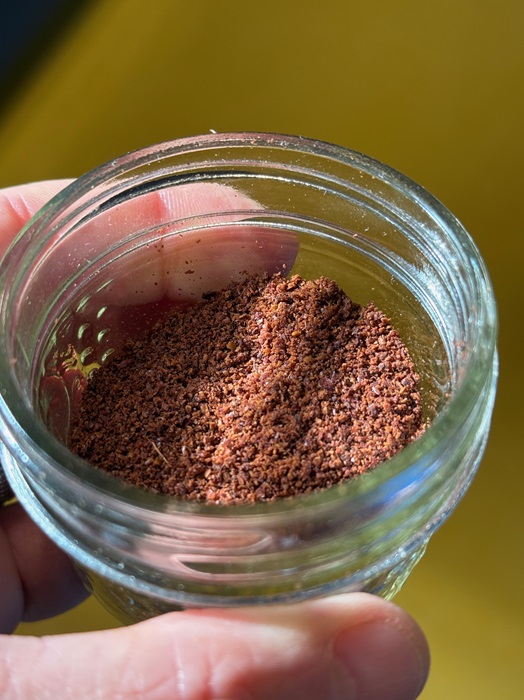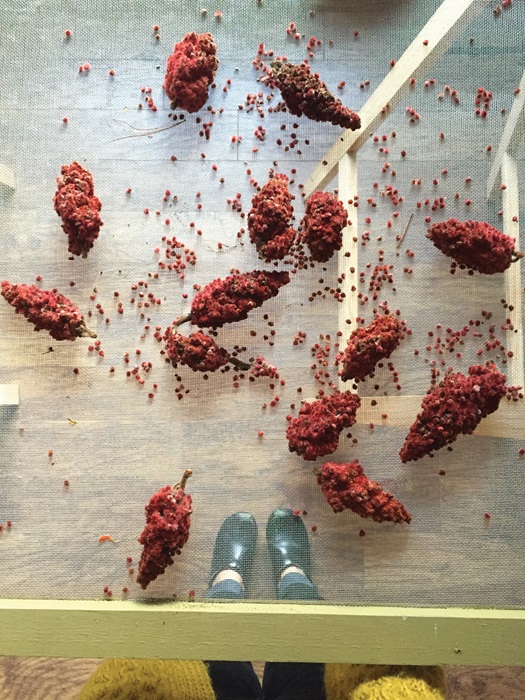In food, as in art, one never quite knows where inspiration will come from. Sometimes the fruits of the season demand attention, such as when the peas come in, or the tomatoes are ripe. Other times, the perfect summer day commands one’s presence at the grill. Last week, an addition to our menu came because I cleaned out the spice cupboard.
I stuck my nose in a mason jar half full of something that looked like paprika, and the scent brought back memories of the lamb meatballs with yogurt-sumac sauce I’d made two years ago. Even though the jar hadn’t seen the light of day for a while, the spice still had good-enough pungency — so, recommended toss-out dates be damned, sumac became my guiding light that day.

That and recipes for a traditional Palestinian dish called mussakhan, for which chicken pieces are rubbed with a marinade bright with sumac and other punchy spices, garlic, and lemon. It’s then roasted in an oven until tender and juicy. The flavors called to me. The oven didn’t. But Christopher was game for an afternoon of grilling, so my riff on mussakhan would add some smoke and sear to the traditional flavors of the dish.
Sumac is a superhero among spices, with the power to bring a fruity acidity to food without any of the bitterness of vinegar. Its flavor is subtle, less overtly citrusy than lemon or lime. One way you might have crossed paths with sumac is in the spice mix za’atar, which is often sprinkled over salads, grilled meats, kebabs, rice, and dips like hummus. But sumac is a valuable spice all on its own.
The spice we see as a powder is made from the berries of shrubs in the genus Rhus, usually from Rhus coriaria, which is native to Iran and grows wild throughout Western Asia, the Arabian Peninsula, and the Mediterranean. Joe Beuerlein, the Independent’s indigenous plant guy, tells me that several native and edible varieties of sumac can be found on roadsides up and down the Cape, including smooth sumac (Rhus glabra), winged sumac (Rhus copallinum), and staghorn sumac (Rhus typhina), which was traditionally used by indigenous Americans to make tart beverages.

Sumac is harvested in late summer to early fall when the berries are fully ripe and bright red. Would-be foragers take note: there are also types of sumac that are poisonous, distinguishable by their white berries. Harvest timing is crucial, as rain can wash away the acidic coating on the berries that gives sumac its distinctive flavor. The berry clusters are sun-dried and then ground whole (some advisers on the process suggest removing the outer “fuzz” first).
For my interpretation of mussakhan for the grill, I borrowed from several different recipes, choosing garlic, Aleppo pepper, coriander, and allspice to combine with the sumac. Other options are cumin, cinnamon, cardamom, and black pepper.
Aleppo pepper is a moderately spicy, fruity variety, with a note of dried tomatoes. Its heat builds slowly in the mouth in a way that’s similar to the ancho chili, so ancho chili powder could be substituted. On the other hand, if you’re adding sumac to your spice cupboard, Aleppo pepper is a great companion spice to keep on hand.
I blitzed the marinade ingredients in a food processor and left bone-in chicken thighs to marinate in the mixture overnight in the refrigerator. I used to marinate proteins in ziplock-type bags, pressing out the air so that the marinade is held in constant contact with all the surfaces. But I’m trying to reduce our plastic use, so marinating the chicken in a glass bowl, turning it a few times, worked just fine.

I grilled some lemon halves and store-bought pita and decided to go all in with sumac by topping the grilled chicken with sumac-pickled red onions. I mixed up a trio of easy sauces: tahini, yogurt-sumac, and a tzatziki made with dill pickles instead of cucumbers, a variation I’d been wanting to try.
Because it was a Saturday and we’re on the Outer Cape, just as Christopher was ready to light the grill it started to rain for the bazillionth weekend in a row. At first it was just a little drizzle, but then the heavens opened up, and my resident master griller raised an eyebrow. We turned on the broiler instead, and the result was chicken with dark, crispy skin and moist flesh, pungent with sumac, garlic, and spices. It was dreary outside, but not around our table, where Christopher said the flavors reminded him of dishes we’d had in Morocco years ago while my brother-in-law Wayne went back for seconds.
GRILLED MUSSAKHAN-STYLE CHICKEN
Makes 8 servings
1 medium onion, coarsely chopped
3 large garlic cloves, coarsely chopped
2 tsp. sumac, plus more for garnish
1 tsp. Aleppo pepper
1 tsp. whole coriander
½ tsp. ground allspice
Juice of one lemon
Extra virgin olive oil
8 bone-in chicken thighs
Kosher salt
Black pepper
2 large lemons, halved
- To make the marinade, add the first seven ingredients and a quarter cup of olive oil to the bowl of a food processor. Pulse several times to create a chunky sauce. If the sauce doesn’t seem liquid enough to coat the chicken, add more olive oil.
- Rub the chicken thighs all over with salt and pepper and then coat them with the marinade in a deep bowl. The chicken should marinate at least an hour, but longer is better and overnight works great. Turn the chicken in the bowl of marinade from time to time. About a half hour before you intend to grill them, remove the thighs from the refrigerator to bring them to room temperature.
- On lightly oiled grates of a gas or charcoal grill, arrange the lemon halves, cut side down, and grill over high heat until they begin to char. Brush the pita bread with olive oil and grill until lightly charred on each side, about a minute. If it’s raining because it’s a Saturday and you’re on the Outer Cape, use your broiler instead.
- Shake the excess marinade off the now room-temperature chicken thighs and pat with paper towels. Grill over high but indirect heat for 5 minutes, skin side down first. Turn and continue to grill, turning occasionally until the chicken’s internal temperature is 155 to 160° F (the temperature will continue to increase during the resting period). Chicken may also be roasted under the broiler.
- Transfer the chicken to a platter, cover loosely with foil and allow to rest for 10 minutes. To serve, pile some of the pickled onions on top of the thighs and sprinkle with additional sumac. Serve with the grilled lemons and pita, along with tahini sauce, yogurt-sumac sauce, or tzatziki.
SUMAC-PICKLED RED ONIONS
Makes about 2 cups
1 large red onion, sliced thin
½ cup red wine vinegar
3 Tbsp. sumac
1 Tbsp. kosher salt
2 Tbsp. parsley, chopped fine
2 Tbsp. mint, chopped fine
In a medium bowl, combine all of the ingredients, tossing together with your hands until well mixed. Allow to marinate for at least an hour. The pickles will keep in the fridge for about a week.
TAHINI SAUCE
Makes about ¾ cup
2 garlic cloves, grated or finely minced
½ tsp. salt
¾ cup tahini paste, well stirred
½ cup freshly squeezed lime or lemon juice
¼ cup cold water
1 cup chopped parsley leaves
As you mince the garlic, add the salt and mash it in as you go, making a paste of the mixture.
- Put the minced garlic, salt, tahini, and citrus juice in a large bowl and stir well. The mixture will thicken as it emulsifies. Add water gradually until the sauce reaches the consistency you like — it should be slightly runny so that it may be drizzled.
- Stir in the parsley leaves. Store covered, in the refrigerator, for up to a week.
YOGURT-SUMAC SAUCE
Makes about 1¼ cups
½ cup sour cream
2/3 cup Greek yogurt
1 tsp. grated zest of lemon or lime
1 clove garlic, crushed
2 Tbsp. olive oil
1 Tbsp. sumac
½ tsp. kosher salt
¼ tsp. black pepper
Mix all ingredients well and chill for at least one hour before serving. Remove the garlic clove before serving, as it is intended only to flavor the sauce subtly. Store covered in the refrigerator for up to a week.
DILL PICKLE TZATZIKI
Makes about 2½ cups
4 whole dill pickles, coarsely grated but not drained, about 1 cup
1 large garlic clove, grated fine
3 Tbsp. extra-virgin olive oil, plus more for serving
2 cups whole Greek yogurt
Salt and black pepper to taste
In a medium bowl, stir the grated pickles and garlic into the oil. Add the yogurt and stir again. Season to taste with salt and pepper (the pickles are already salty so you might not need more). Serve drizzled with more oil. This preparation seems to maintain its flavor and consistency longer than a traditional recipe made with fresh cucumber, making it an ideal dip to keep in the refrigerator for impromptu summer guests. Keeps about a week, refrigerated.
